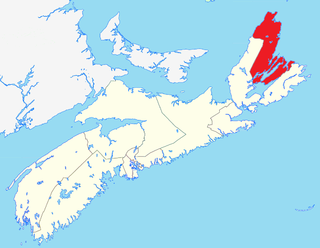
Cape Breton—Canso is a federal electoral district in Nova Scotia, Canada, that has been represented in the House of Commons of Canada since 2004. Its population in 2011 was 75,247. It is the successor to Bras d'Or, which was represented in the House of Commons from 1997 to 2004.

Central Nova is a federal electoral district in Nova Scotia, Canada that was represented in the House of Commons of Canada from 1968 until 1996. In 1996, Antigonish County and part of Guysborough County were placed with Pictou County in a new electoral boundaries configuration to form the electoral district of Pictou-Antigonish-Guysborough. A new version of Central Nova was established in 2003 and — in conjunction with the Pictou-Antigonish-Guysborough iteration — represented a significant electoral boundaries change with specific reference to Antigonish County. Between 1867 and 1997, Antigonish County was not in a riding that included Pictou County; rather, it comprised either its own electoral district (Antigonish), or part of other districts shared with Eastern Nova Scotia (Antigonish-Guysborough) and Cape Breton Island communities. In 2013, part of Antigonish County was "placed back" with communities in the electoral district of Cape Breton Canso, a riding which had emerged in part from the former Cape Breton Highlands Canso riding in 1996. The current version of Central Nova includes Pictou County, parts of Antigonish and Guysborough Counties and extends into Halifax Regional Municipality.
Annapolis was a federal electoral district in Nova Scotia, Canada, that was represented in the House of Commons of Canada from 1867 to 1917. The district was created in the British North America Act, 1867. It was abolished in 1914 when it was redistributed into Digby and Annapolis. It consisted of Annapolis County, Nova Scotia.
Antigonish was a federal electoral district in Nova Scotia, Canada, that was represented in the House of Commons of Canada from 1867 to 1917. It was created in the British North America Act, 1867. The federal riding was dissolved in 1914 into the riding of Antigonish—Guysborough. It consisted of the County of Antigonish.
Cape Breton was a federal electoral district in Nova Scotia, Canada, that was represented in the House of Commons of Canada from 1867 to 1904. It was created as part of the British North America Act, 1867.

Sydney—Victoria is a federal electoral district in Nova Scotia, Canada, that has been represented in the House of Commons of Canada since 1997.
Richmond was a federal electoral district in the province of Nova Scotia, Canada, that was represented in the House of Commons of Canada from 1867 to 1917. It was created by the British North America Act, 1867. It consisted of the County of Richmond. A law to abolish the riding was passed to merge it with Cape Breton South into Cape Breton South and Richmond in 1914. This was duly carried out when the first elections were held with new boundaries and the new name in 1917.
Victoria was a federal electoral district in Nova Scotia, Canada, that was represented in the House of Commons of Canada from 1867 to 1904. It was created by the British North America Act, 1867. It consisted of the County of Victoria. It was abolished in 1903 when it was merged into North Cape Breton and Victoria electoral district.
Cape Breton South was a federal electoral district in the province of Nova Scotia, Canada, that was represented in the House of Commons of Canada from 1904 to 1911 and from 1925 to 1968.
Antigonish—Guysborough was a federal electoral district in Nova Scotia, Canada, that was represented in the House of Commons of Canada from 1917 to 1968.
Richmond—West Cape Breton was a federal electoral district in the province of Nova Scotia, Canada, that was represented in the House of Commons of Canada from 1925 to 1935. This riding was created in 1924 from Cape Breton South and Richmond riding. It consisted of the County of Richmond and the part of the County of Cape Breton lying east of East Bay and south of the electoral district of Cape Breton South. It was abolished with a law passed to merge Richmond—West Cape Breton into Inverness—Richmond in 1933, which was duly carried out in 1935 with the election of the first member to the new riding.
Cape Breton North and Victoria was a federal electoral district in the province of Nova Scotia, Canada, that was represented in the House of Commons of Canada from 1904 to 1968.
Inverness—Richmond was a federal electoral district in the province of Nova Scotia, Canada, that was represented in the House of Commons of Canada from 1935 to 1968.
Cape Breton Highlands—Canso was a federal electoral district in the province of Nova Scotia, Canada, that was represented in the House of Commons of Canada from 1968 to 1997.
Cape Breton—East Richmond was a federal electoral district in Nova Scotia, Canada, that was represented in the House of Commons of Canada from 1968 to 1997.
Cape Breton—The Sydneys was a federal electoral district in Nova Scotia, Canada, that was represented in the House of Commons of Canada from 1968 to 1997.

George William Kyte, was a Canadian politician from the province of Nova Scotia.

Cape Breton East is a provincial electoral district in Nova Scotia, Canada, that elects one member of the Nova Scotia House of Assembly. The riding is represented by Brian Comer of the Progressive Conservative Party.
Edward Charles Doyle was a Canadian politician. He represented the electoral district of Richmond and Cape Breton West in the Nova Scotia House of Assembly from 1928 to 1930. He was a member of the Nova Scotia Liberal Party.




